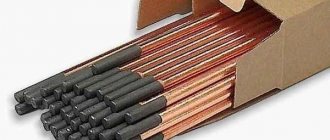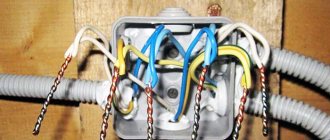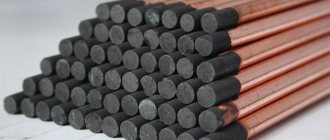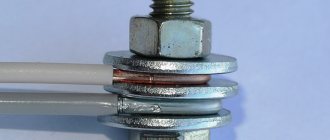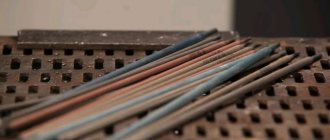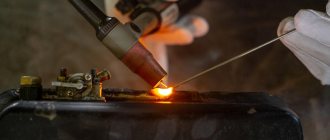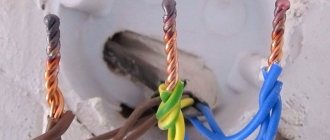Carbon electrodes are rarely used in welding work, but professionals are not yet ready to completely abandon them. One of the oldest methods of joining metal has important advantages over its metal counterparts.
Carbon arc welding is one of the oldest methods of joining metals. It was invented back in 1882. The author of the development was Russian engineer Nikolai Bernardos. Over time, carbon rods gave way to metal rods and today they are used very rarely. However, it is too early to abandon them completely.
Properties and varieties
A carbon electrode is a solid rod consisting of coal (coke) and several additives. Resin is used here as a binding element.
These rods can be used to weld all types and varieties of metals - from refractory and heavy to light and porous. The diameter of the carbon electrode can vary from 1.5 to 25 mm, and the length - from 25 to 300 mm (the longest are used when the parts to be connected are located in a hard-to-reach place). They can also have different shapes:
- round;
- semicircular;
- rectangular;
- hollow.
In most situations, round and semicircular electrodes are used for work - this is the best option for obtaining a standard weld.
Rectangular products are mainly used to seal defects on steel surfaces, while hollow ones are characterized by the fact that they are capable of creating a U-shaped groove at the joint.
It is also worth knowing that in addition to the usual ones, there are copper-plated carbon electrodes. They are coated with copper to increase strength, but all other performance properties remain approximately the same.
Description of technology
At the beginning of work (both before welding and before gouging), preparation is always carried out. It includes cleaning the welding zone of the surface of the part. Cleaning is carried out with sandpaper, a grinding machine or a file.
All pockets of corrosion, inclusions of foreign materials, dirt, and unevenness are removed. After this, the surface is treated with a degreasing liquid. The quality of the welding joint will depend on the quality of the stripping.
The current level is set depending on the diameter of the electrode. With a size of 4 mm, the current should reach 150-200 Amperes. If the size of the rod is larger, the current strength increases, if smaller, it decreases.
For stability of the arc, it is worth setting up a constant type of current. The polarity is set to negative. This will also reduce material consumption.
To improve the density of the seam and stabilize the arc during gouging and welding, flux is used. They exist in several types: powder, paste, liquid. You can use any, but for use at home, a paste or liquid form is more suitable.
For best effect, the flux must include ionizing substances. The flux itself is applied to the welding surface and distributed in a thin, uniform layer.
Next, the filler element is inserted into the holder, the arc is ignited and a weld pool is formed. The arc is ignited by tapping (striking) the tip of the working element on a metal surface.
During operation, the visible part of the filler element should not exceed 7 cm. Advancement along the joint should be uniform, taking into account the melting of the edges and the formation of the joint.
Welding parts, as well as gouging with a carbon electrode, can be done at home, but for this you need to use factory-made equipment. Homemade units are not suitable for such welding due to the lack of ability to adjust the current strength.
Process Features
Electrodes made from coal differ from metal ones in that they are infusible. This means that during welding they act as a conductor of electricity, but do not become part of the weld pool.
During operation, the carbon rods heat up to very high temperatures. And if you continue heating, then almost immediately they will go from a molten state to a boiling state (by the way, coal boils at a temperature of 4200 ° C).
Due to the characteristics of the material, only direct electric current of straight polarity can be used in the welding process. Accordingly, the minus (cathode) here should be on the electrode, and the plus (anode) on the metal surface of the product.
When working with carbon electrodes, the welder usually requires filler elements. In this case, welding can be done in two ways:
- from left to right (in this case, the additive is behind the electrode);
- from right to left (there is an additive in front).
Interestingly, when welding from left to right, thermal energy is used more efficiently, and this allows you to increase the speed of work. However, in practice you can often find the “right to left” technology - it is more familiar.
In some situations, you can do without an additive, for example, when flanging thin metal products or when welding corner joints . Moreover, if you use a carbon electrode without additives to join metal sheets with a thickness of up to 3 mm, then the productivity will be an order of magnitude greater than when welding with other electrical conductors.
Do-it-yourself welding with a graphite rod
When making miniature homemade products, sometimes it is necessary to weld thin-walled parts that a conventional welding machine simply burns through. In this case, you can use a car or motorcycle battery to weld the workpieces. This solution is also suitable for connecting twisted electrical wires in junction boxes.
Accessories:
- battery 12V;
- crocodile clips – 3 pcs.;
- powerful copper wires, preferably up to 1 m long – 2 pcs.;
- R20 battery (used will do).
Assembling the welding machine
A graphite rod from an R20 battery will be used as a welding electrode in this homemade product. It is easily removed after cutting its body in a circle.
Clamps are attached to the ends of the wires stripped of insulation. There are 2 crocodiles on one cable, and one clip and a graphite rod on the second.
There is no need to use long wires during assembly. The battery power is too small to overcome their resistance. The shorter the cable, the better.
A wire with two clamps is connected to the negative terminal of the battery. The cable crocodile with a rod is placed on the positive terminal.
How to use
Before welding begins, the free crocodile from the negative terminal of the battery is clamped onto one of the workpieces. It will perform the function of mass. The rod will act as an electrode. Its end is briefly touched to the suture site.
The electrode gets hot, so it is better to hold it with pliers. The graphite becomes hot and begins to melt the thin metal. To avoid burning the part, the electrode should be moved slowly along the joint line of the workpieces, sometimes interrupting.
In the first seconds, the graphite smokes heavily until the remaining electrolyte from the battery burns out.
You can weld with a seam or do spot welding. In the latter case, it is worth pre-drilling holes in the upper part to be connected. This device is also suitable for soldering. It can be used to heat a part and then apply solder to it.
Welding with a battery wears out the battery, so you should not get carried away with this method. It is important to keep the electrode closed for no more than a few seconds at a time.
Under the stress of welding, the battery becomes hot and may rupture. The signal for this will be the noise of electrolyte boiling emanating from it. The larger the battery, the larger and thicker the workpieces can be welded.
Typically the battery charge is sufficient to operate for several minutes.
Autonomous welding from batteries with your own hands!
The welding machine uses a fairly low (tens of volts) voltage and high current to create an arc, which actually melts the metal.
What if you use for this purpose not mains voltage with a bulky transformer, but... batteries? Unexpected, right? But nothing is impossible here.
Conventional batteries provide almost the same voltage that is needed for welding, only lower - 12 Volts.
Theoretically, you can get an arc from one 12-volt battery, but it will be so short that cooking with it is a hassle. For reliable and convenient operation, you will need three 12 Volt lead batteries, which in total will give 36 Volts.
It is best to take car ones - their current is enough even for thick electrodes (4 mm), but you can also use batteries from uninterruptible power supplies or motorcycle ones.
In this case, you will have to limit yourself to thin electrodes (no thicker than 2 mm), and the welding itself will take more time.
Scheme
The scheme is simple, but pay attention to the following subtleties:
- all connections must be very good, since at low voltage heating and losses increase greatly due to poor contact (it is best to use conductive paste);
- The cross-section of the wires between the batteries and from the batteries to the terminals should not be less than 16 square meters. mm (better - 25 square), of course, only copper will do;
- it is not the minus that is connected to the part (that is, the ground clamp), but the plus - accordingly, the minus is connected to the electrode, and welding must be done with “blue” electrodes (for example, MP-3S);
- if the electrode is stuck, try to tear it off, since long-term operation in short circuit mode is harmful to batteries - they do not have built-in protection (see also below);
- to protect the batteries from overheating in the event of a strong “sticking”, connect a short piece of wire of 2.5 squares between the batteries, preferably on a screw terminal, so that it can be easily changed: if there is a strong overload, it will burn out and prevent the batteries from overheating.
conclusions
Of course, this “welding machine” is not as convenient as a regular one; in the end, the batteries will run out and will have to be charged. But if you need to cook infrequently and away from 220 Volt outlets, this solution has a right to life.
Welding copper wires with a graphite electrode
In modern wire joining, carbon electrodes are increasingly being used to weld the ends of copper wires. This method replaces the outdated method of soldering copper strands. This does not require the use of solder or flux.
The task of welding is the same as with soldering - it is to ensure reliable and durable contact between two or even several wires, since this cannot be achieved with a conventional connection.
Over time, a film will certainly appear on the surface of copper due to oxidation. After the welding process, the junction of the cores is welded differently than during soldering; soldering occurs only at the tip.
However, even such formed contact at an increased load prevents overheating of the welded cable cores.
Graphite electrode for welding
Due to its technical characteristics, the graphite electrode is easy to cut , consumes more slowly, and does not crack during welding.
As practice shows, welding of wire cores is carried out in distribution boxes. The boxes are located quite high, so you will need to use portable welding equipment for welding.
Industrial devices are used for these purposes, the use of which is advisable in a professional sense. If possible, you can assemble the welding machine yourself. However, for most people, inverter-type devices, which are presented in a large assortment in stores, are perfect. They are compact, mobile, lightweight and also have the ability to adjust the welding current you need.
Types of electrodes for welding copper wire cores
When welding copper conductors, appropriate electrodes . We have already mentioned carbon electrodes. There is also a graphite type of electrodes. Battery rods, brushes of commutator motors and similar products made of graphite can be used as an electrode in household use.
Graphite rods are a good replacement for purchased electrodes, with the only exception that they do not have copper plating, but this can be solved by improving the holder.
To do this, it will be necessary to use an alligator clip, both for the electrode and for the ground connection. They will not be as bulky as standard ones, so it will be more convenient for you to work in switchboards.
Of course, you will need to take care of additional insulation of the handles.
Use in home workshops
To work with carbon electrodes at home, a standard electric arc welding machine is suitable. Since the thermal conductivity of carbon rods is low, an arc can be created with a current of only 3-5 Amperes.
Moreover, this electric arc, if necessary, extends to a length of 30-50 millimeters. The electrode evaporates slowly and does not stick to the metal, so it is quite easy to guide the carbon arc in the direction of the future seam.
The skills needed to perform simple jobs (such as welding wires, welding thin metal plates, etc.) are acquired very quickly in this case.
Home craftsmen should not cook outdoors, but strictly indoors. The carbon arc reacts to wind blows, gas flows, magnetic fields and other influences.
In order not to waste time rearranging the electrode in the holder and so that it does not get too hot during welding, it can be sharpened at both ends in advance. When one end overheats, the electric holder is rotated 180° and welding continues with the other end.
Craftsmen who do not have too many consumables on hand should use this advice.
Some specialists use carbon and graphite electrodes to weld copper busbars at transformer substations. And in home handicraft workshops, such electrodes can, for example, weld copper wires.
Bronze rods would be a good filler material in this situation. The diameters of such rods are selected depending on the thickness of the parts being welded and are calculated using special formulas.
In addition, carbon electrodes can be used to perform not only welding work, but also cutting operations on metal products.
Carbon gouging
Carbon gouging is a metal cutting method that uses compressed air. An electric arc melts the metal, and a jet of compressed air directed at the welding area blows it out.
Air carbon arc gouging or gouging can be used to cut all types of metals. But mainly this technological process is used for cutting stainless steel, cast iron, nickel, aluminum and copper.
Carrying out welding work using suitable rods is used only in exceptional cases when it is necessary to make a strong and even weld. This technology has many important features that must be observed when performing it. But the selection of carbon rods used for welding is of particular importance.
Description of technology
Air arc cutting is applicable at home. However, as with other treatments, safety is important when cutting.
Before starting welding and gouging work, the equipment is checked for serviceability. As well as metal preparation - cleaning and degreasing. After this, the welding mode is adjusted and the current parameters are set.
You should not set this parameter to high values. Excessive current will quickly evaporate the copper coating of the filler material. This will affect the quality and uniformity of melting of the body of the part.
In addition to welding equipment, a compressed air cylinder is prepared. It should not have any damage or dents.
After making sure that the cylinder is in good condition, the pressure is adjusted. For air arc gouging, four to six bar is sufficient.
The filler element is inserted into the holder so that the visible part does not exceed a length of 10 cm. Air is supplied and the arc is ignited.
After the formation of the weld pool, compressed air is directed to the working area. Both parts of the treatment should be carried out evenly.
